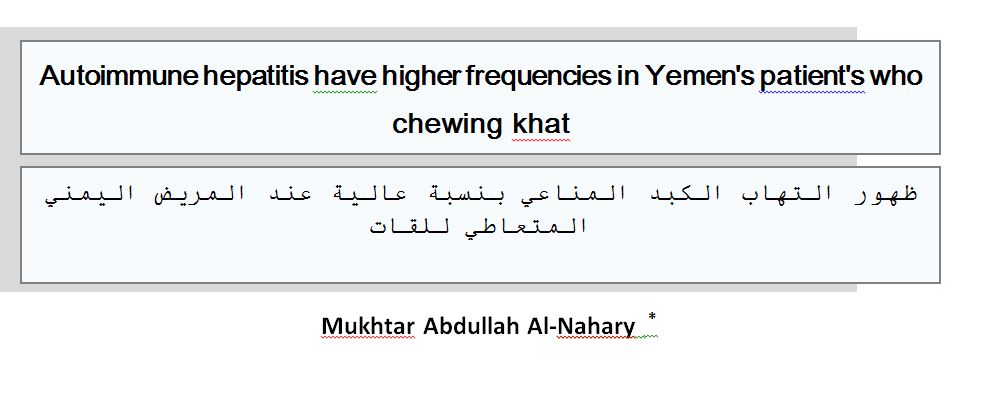ظهور التهاب الكبد المناعي بنسبة عالية عند المريض اليمني المتعاطي للقات Mukhtar Abdullah Al-Nahary *
محتوى المقالة الرئيسي
الملخص
شجرة القات نبات شائع ينمو في اليمن وشرق إفريقيا (مناطق شرق وغرب هارج في إثيوبيا) وله العديد من الأضرار الصحية والاجتماعية والاقتصادية. وبسبب قلة الوعي في هذا المجال وقلة البحث نجد صعوبة السيطرة على هذه الظاهرة ونجد أن من يستهلك القات يعانون من مشاكل صحية كثيرة خطيرة وقد تؤدي إلى الوفاة. ومن هذه المخاطر الآثار الضارة لتعاطي القات على كبد الإنسان. يعرض هذا البحث الضرر الذي تسببه شجرة القات للإنسان وأنه سبب رئيسي لالتهاب الكبد وأمراض الكبد المناعية الذاتية حيث تم عرض الأجسام المضادة الذاتية لـ ANA و ASMA في المرضى الذين لا يعانون من أمراض الكبد المزمنة. تم إجراء الفحوصات السريرية واختبارات الدم والبول والموجات فوق الصوتية للبطن لمجموعة من 420 مريضاً تتراوح أعمارهم بين 18-45 سنة من مختلف مدن تعز والتربة ولحج وقراهم في الجمهورية اليمنية. تم اقتراح عقار بريدنيسالون المثبط للمناعة (0.5 مجم / كجم / يوم) و Ursochol 250 مجم (10 مجم / كجم / يوم) وعلامة التبويب Livbest (قرصان مرتين يوميًا) وتم إعطاؤهما نتائج ممتازة لجميع المرضى. بعد العلاج وحسب المدة المقترحة في البحث ثلاثة أسابيع وتستمر لمدة شهر حتى تصبح جميع إنزيمات الكبد طبيعية. بعد ذلك توقف العلاج نهائيا وامتنع عن تناول القات لمدة ثلاثة أشهر حيث كانت نسبة الشفاء التام 315 من 420 باستثناء 80 حالة مع ارتفاع ضعيف في إنزيمات الكبد و20 حالة فيها اجسام مضادة مناعية. (ASMA) بقيت إيجابية بدون أعراض و 5 حالات من الأجسام المضادة المناعية (ANA) إيجابية بدون أعراض. من خلال النتائج اتضح أن العلاجات المقترحة في البحث لها تأثير جيد في علاج مثل هذه الحالات ويمكن إيقافها بعد تحسن وظائف الكبد طالما امتنع عن مضغ القات.
الكلمات المفتاحية: القات , الأجسام المضادة , الكبد المناعي , الأجسام المضادة , ASMA, ANA.
الطبقة الوسطى للشريان السباتي ,الاضطرابات بالأشعة التلفزيونية
تفاصيل المقالة
المراجع
Reference
Pehek EA, Schechter MD, Yamamoto BK. Effects of cathinone and amphetamine on the neurochemistry of dopamine in vivo. Neuropharmacology29(12):1171-6, 1990.
Giannini A, Castellani S. A manic-like psychosis due tockhat. J Toxicol Clin Toxicol,19(5):455-9, 1982.
Critchlow S, Seifert R. Khat induced paranoid psychosis. Br J Psychiatry;150;247-9, 1987.
McLaren P. Khat psychosis. Br J Psychiatry 1987;150:712-3.
Yousef G, Huq Z, Lambert T. Khat chewing as a cause of psychosis. Bri J Hosp Med (Lond),54(7):322-6, 1995.
Kalix P. Catha edulis, a plant that has amphetamine effects. Pharm World Sci, 18(2):69-73, 1996.
Al-Motarreb A, Baker K, Broadley KJ. Khat: Pharmacological and medical aspects and its social use in Yemen. PhytotherapyRes,16(5):403-13, 2002a.
Toennes, S.W.; Harder, S.; Schramm, M.; Niess, C.; Kauert, G.F. Pharmacokinetics of cathinone, cathine and norephedrine after the chewing of khat leaves. Br. J. Clin. Pharmacol, 56, 125-130, 2003.
Widler, P.; Mathys, K.; Brenneisen, R.; Kalix, P.; Fisch, H.-U. Pharmacodynamics and pharmacokinetics of khat: A controlled study. Clin. Pharmacol. Ther 55, 556-562, 1994.
Gunaid AA, Sumairi AA, Shidrawi RG, Al-Hanaki A, Al-Haimi M, Al-Absi S, Al-Huribi MA, Qirbi AA, Al-Awlagi S, El-Guneid AM, Shousha S, Murray-Lyon IM. Oesophageal and gastric carcinoma in the Republic of Yemen. British Journal of Cancer, 71: 409-410, 1995.
Benson PB, Mcdermott W, editors: Cecil-Loeb Textbook of Medicine, Philadelphia, W. B. Saunders Co, 107-149. 13, 1971.
Heymann TD, Bhupulan A, Zuriekat NEK, Bomanji J, Drinkwater C, Giles P. Murray-Lyon IM. Khat chewing delays gastric emptying of a semi-solid meal. Aliment Pharmacol Ther, 9: 81-83, 1995.
Hill, C.M.; Gibson, A. The oral and dental effects of q’at chewing. Oral. Surg. Oral. Med. Oral. Pathol, 63, 433-436, 1987.
Abebe, W. Khat: A Substance of Growing Abuse with Adverse Drug Interaction Risks. J. Natl. Med Assoc, 110, 624-634., 2018.
Valente, M.J.; de Pinho, P.G.; Bastos, M.D.L.; Carvalho, F.; Carvalho, M. Khat and synthetic cathinones: A review. Arch. Toxicol, 88, 15-45, 2014.
Engidawork, E. Pharmacological and Toxicological Effects of Catha edulisF. (Khat). Phytotherapy Res, 31, 1019-1028,2017.
Ahmed, A.M. Effect of Khat on the Heart and Blood Vessels. Heart Views, 5, 54-57, 2004.
Chapman, M.H.; Kajihara, M.; Borges, G.; O_Beirne, J.; Patch, D.; Dhillon, A.P.; Crozier, A.; Morgan, M.Y. Severe, Acute Liver Injury and Khat Leaves. N. Engl. J. Med, 362, 1642-1644, 2010.
Stuyt, R.J.L.;Willems, S.M.;Wagtmans, M.J.; Van Hoek, B. Chewing khat and chronic liver disease. Liver Int, 31, 434-436, 2011.
Abdulsamad Alsalahi, Mahmood Ameen Abdulla, Mohammed Al-Mamary, Mohamed Ibrahim Noordin, Siddig Ibrahim Abdelwahab, Aied M. Alabsi, Abdrabuh Shwter, Mohammed A. Alshawsh, "Toxicological Features of Catha edulis (Khat) on Livers and Kidneys of Male and Female Sprague-Dawley Rats: A Subchronic Study", Evidence-Based Complementary and Alternative Medicine, vol. 2012, Article ID 829401, 11 pages, 2012. https://doi.org/10.1155/2012/829401, 2012.
